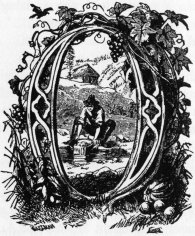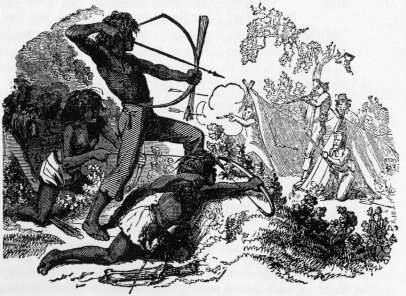Yosemite > Library >
Heart of the Sierras >
Early Incidents >
Next: Chapter 7
•
Index
•
Previous: Chapter 5
In the Heart of the Sierras by James M. Hutchings (1888)
CHAPTER VI.
EARLY HISTORICAL INCIDENTS.
Ill habits gather by unseen degrees.
As brooks make rivers, rivers run to seas.
—Dryden’s
Ovid, Metamorphoses, Bk. XV
|
|
Guilt’s a terrible thing.
—Ben Jonson’s
Bartholomew Fair.
|
Angels for the good man’s sin
Weep to record, and blush to give it in.
—Campbell’s
Pleasures of Hope.
|
Chafing under the restraint attending his residence at the
reservation, in addition to many tribal squabbles, and the ostensible
lack of dignity showed him by his fellow-captives, Ten-ie-ya implored
permission to return to his home in the mountains, promising
faithfully to conform to every requirement asked of him by the
Commissioners. This permission was eventually conceded, under
certain conditions, and the old chief, with his family, was once more
allowed to return to the Yo Semite. Other members of his tribe,
shortly after Ten-ie-ya’s departure, silently stole away from the
reservation and joined him; “but as no complaints were made by
their chiefs, it was understood that they were glad to get lid of
them; therefore no effort was made to bring them back.”
After the severe lessons already taught these renegades, it was
reasonable to suppose that they would have accepted the situation,
and kept upon their best behavior, but with the return of winter
came also the Indians, and with them their old bad habits.
Numerous animals being missed from their pasture-grounds, it was
presumed that the Yo Semites had stolen them; “but as some of
them were found in the possession of Mexicans, who were promptly
executed for the theft, no charge was preferred against the Yo
Semites.”
 N or about May 28th, 1852,*
a
party of five prospectors for
gold, consisting of Messrs. Tudor,
Grover, Sherman—or Sherbon—Babcock,
and Rose, left
Coarse Gold Gulch, Fresno
County (now used as one of the
stage routes between Madera
and Wawona), for the Yo Semite
Valley. They had scarcely
entered it before they were
attacked by Indians, that lay in
ambush among the rocks, at the
foot of the old Indian trail. Rose
and Sherman—or Sherbon, as Dr. Bunnell gives it—were instantly
killed. Tudor was seriously wounded; but he and the others
secreted themselves among the rocks, and fought the Indians,
until darkness enabled them to make good their escape.
N or about May 28th, 1852,*
a
party of five prospectors for
gold, consisting of Messrs. Tudor,
Grover, Sherman—or Sherbon—Babcock,
and Rose, left
Coarse Gold Gulch, Fresno
County (now used as one of the
stage routes between Madera
and Wawona), for the Yo Semite
Valley. They had scarcely
entered it before they were
attacked by Indians, that lay in
ambush among the rocks, at the
foot of the old Indian trail. Rose
and Sherman—or Sherbon, as Dr. Bunnell gives it—were instantly
killed. Tudor was seriously wounded; but he and the others
secreted themselves among the rocks, and fought the Indians,
until darkness enabled them to make good their escape.

|
| THE ATTACK. |
The arrival of the survivors in Mariposa with the exciting
news of these murders, and the renewal of Indian hostilities,
very naturally stirred up the old defiant hate, and the Indian
Commissioners were blamed for permitting Ten-ie-ya’s return.
It was, moreover, feared that this would be a signal for the
wholesale desertion of Indians from the reservation. Instead of
this, however, those living on the outside fled within for protection,
fearing that the guilt of others would be visited upon their
own heads.
UNITED STATES EXPEDITION SENT AGAINST THE YO SEMITES.
The officer in command at Fort Miller, on the San Joaquin
River, was informed, by special courier, of these murders; when a
detachment of regular soldiers, under Lieutenant Moore, U.S.A.,
was immediately sent out against the enemy, accompanied by
scouts and guides that had formed portions of the first and second
expeditions, and a few friends of the murdered men. They
surprised and captured five of the Indians; the others, led by
Ten-ie-ya, fled and escaped. The naked bodies of the murdered
men were found, and buried, near the Pohono, or Bridal Veil Fan.
Satisfied of the proof being conclusive that the Indians caught
were the blood-stained murderers of the whites, the clothing of
the murdered men being found upon their persons, Lieutenant
Moore ordered them to be shot upon the spot.
These effectually disposed of, Moore and his forces, after
searching for the remaining Yo Semites in their hiding-places
about the valley, pursued them into, and even across the mountains
to, the Mono country; but as the Indians had every advantage,
both in the start, and in their knowledge of the ways and
by-ways of escape, they were never overtaken, and the command
reluctantly returned to Fort Miller, without a single prisoner as a
trophy.
THE YO SEMITES NEARLY EXTERMINATED BY THE MONOS.
Nothing more was heard of the Yo Semites, after their successful
flight to, and hiding among, the Monos, with whom they
found shelter and protection, until the early summer of 1853,
when, being dissatisfied with their dependent position, and more
so with the locality assigned them, they returned once more to
the Yo Semite Valley. Fearing the just retaliation of the whites,
however, they made their abiding places among the talus, whence
they could notice every movement of the enemy, without themselves
being seen. There are several of these places of shelter still
to be found among the rocks near Indian Cañon, and elsewhere.
Life, in their old home, unspiced with mischief, became unbearably
monotonous to them after the habit had been acquired,
and learning through their runners that the Monos had stolen a
large band of fine horses from the vicinity of Los Angeles, the Yo
Semites became jealously uneasy, and planned a foraging excursion,
to obtain some of this living plunder for their own use;
indulging the impression that it would be safer, under present
circumstances, to steal from the Monos than from the whites. The
raid was accordingly executed with masterly cunning, and their
arrival with the stolen horses successfully accomplished. By this
time they had mustered sufficient courage to form an encampment
down in the valley, near the mouth of Indian Cañon, where,
according to
Dr. Bunnell, who is probably the best informed of
any man living, on such topics:—
After a few days’ delay, and thinking themselves secure, they killed
one or more of the horses, and were in the enjoyment of a grand feast in
honor of their return, when the Monos pounced down upon them. Their
gluttony seemed to have rendered them oblivious to all danger to themselves,
and of the ingratitude by which the feast had been supplied. Like
sloths, they appear to have been asleep after having surfeited their
appetites. They were surprised in their wigwams by the wronged and
vengeful Monos, and before they could rally for the fight, the treacherous
old chief was struck down by the hand of a powerful young Mono chief.
DEATH OF TEN-IE-YA, THE LAST CHIEF OF THE YO SEMITES.
Ten-ie-ya had been the principal object of attack at the commencement
of the assault, but he had held the others at bay until discovered by
the young chief, who, having exhausted his supply of arrows, seized a
fragment of rock and hurled it with such force as to crush the skull of
“the old Grizzly.” As Ten-ie-ya fell, other stones were cast upon him by
the attacking party, after Pai-ute custom, until he was literally stoned to
death. All but eight of Ten-ie-ya’s young braves were killed; these escaped
down the valley, and through the cañon below. The old men and women
who survived the first assault were permitted to escape from the valley.
The young women and children were made captives, and taken across the
mountains to be held as slaves or drudges to their captors.
Thus substantially ended the once famous tribe of the Yo
Semites. The few that escaped eventually found their way to
“Hunt’s Store” on the Fresno. It was from these that we
obtained our Indian guides in 1855, as related in the
ensuing chapter.
DEATH OF MAJOR SAVAGE.
Before closing this recital, it may not be deemed irrelevant
to state that Major Savage, the chosen officer of command for
the Mariposa Battalion, fearing that the best interests of the
Indians were being jeoparded by the course of speculative
and unscrupulous men, denounced some of the leaders in unmeasured
terms. This brought on a personal altercation, and
re-encounter, between Savage and a man named Harvey, which
ended in the death of Savage, August, 1852.
The Indian tribes represented in the Peace Treaty were as
follows: The Howechais, Chookchancies, Chowchillas, Pohonoches,
Nootchoos, Pitcaches, Capoos, Toomanehs, Tallinchees,
Poskesas, Wachahets, Itaches, Choenemnes, Chokimenas, Notohotos,
and Narmelches—16.*
As
Dr. Bunnell
most graphically states: “It was a well
known fact that these people [the Indians] preferred horse-flesh
and their acorn jelly to the rations of beef that were supposed to
have been issued by the Government;” and, moreover, as an ultimate
sequence, the reservation on the Fresno gradually be
came unpopular on this account, but mainly, from bad
management; was afterwards abolished by the Government;
and, finally, its lands and buildings were gobbled up by sharp-sighted,
if not unprincipled men who, like many others of that
class, became rich out of the acquisition.
Next: Chapter 7
•
Index
•
Previous: Chapter 5
http://www.yosemite.ca.us/library/in_the_heart_of_the_sierras/06.html
 N or about May 28th, 1852,*
[* Elliott’s “History of Fresno County."]
a
party of five prospectors for
gold, consisting of Messrs. Tudor,
Grover, Sherman—or Sherbon—Babcock,
and Rose, left
Coarse Gold Gulch, Fresno
County (now used as one of the
stage routes between Madera
and Wawona), for the Yo Semite
Valley. They had scarcely
entered it before they were
attacked by Indians, that lay in
ambush among the rocks, at the
foot of the old Indian trail. Rose
and Sherman—or Sherbon, as Dr. Bunnell gives it—were instantly
killed. Tudor was seriously wounded; but he and the others
secreted themselves among the rocks, and fought the Indians,
until darkness enabled them to make good their escape.
N or about May 28th, 1852,*
[* Elliott’s “History of Fresno County."]
a
party of five prospectors for
gold, consisting of Messrs. Tudor,
Grover, Sherman—or Sherbon—Babcock,
and Rose, left
Coarse Gold Gulch, Fresno
County (now used as one of the
stage routes between Madera
and Wawona), for the Yo Semite
Valley. They had scarcely
entered it before they were
attacked by Indians, that lay in
ambush among the rocks, at the
foot of the old Indian trail. Rose
and Sherman—or Sherbon, as Dr. Bunnell gives it—were instantly
killed. Tudor was seriously wounded; but he and the others
secreted themselves among the rocks, and fought the Indians,
until darkness enabled them to make good their escape.
